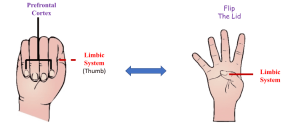In this series, we are going to talk about two areas of the brain: downstairs and upstairs (Siegel & Bryson, 2011). If you haven’t already checked out “Brain Architecture-Upstairs/Downstairs Brain” https://www.youtube.com/watch?v=dk1Nt-xnSGI. This video will help describe a little bit about each part. Also, make sure you have checked out past posts on trauma, ACEs and the foundation of impact of trauma on the brain.
Hand Model of the Brain
One way to understand the upstairs and downstairs areas of the brain is to use what Dan Siegel calls the “Hand Model of the Brain”. Hold your hand up, either one. Make a number four with your fingers and your thumb pulled in. Now fold your fingers on top of your thumb. This is a model of your brain. The front part of your fingers is the prefrontal cortex, in this case the upstairs brain. This area is responsible for logical thinking (Problem Solving Patty), calming (Calming Carl), flexibility (Flexible Felix) and focus (Focusing Frank), etc. It puts language into emotions, e.g. “I feel…”. This the last part of the brain to develop. Now lift your fingers. This area represents the downstairs brain; the thumb and palm. These areas represent the limbic system; they are responsible for keeping you safe by watching out for danger (Alerting Annie) and producing strong emotions like anger (Angry Albert) and fear (Frightened Fred). The thumb itself represents the amygdala (Big Boss Bob). This is the watchdog of the brain (Siegel) because it is taking in information from other parts of the lower brain (Alerting Annie, Angry Albert, and Frightened Fred) and acting to keep you safe through fight, flight, or freeze. The downstairs brain is responsible for keeping you safe or saving your life. One thing to note is that the downstairs brain is responsible for intense emotions, which means that thinking and reasoning don’t happen here.
represent the limbic system; they are responsible for keeping you safe by watching out for danger (Alerting Annie) and producing strong emotions like anger (Angry Albert) and fear (Frightened Fred). The thumb itself represents the amygdala (Big Boss Bob). This is the watchdog of the brain (Siegel) because it is taking in information from other parts of the lower brain (Alerting Annie, Angry Albert, and Frightened Fred) and acting to keep you safe through fight, flight, or freeze. The downstairs brain is responsible for keeping you safe or saving your life. One thing to note is that the downstairs brain is responsible for intense emotions, which means that thinking and reasoning don’t happen here.
Let’s put our fingers back down to form our whole brain. We call this the fully integrated brain; The downstairs and upstairs of the brain are working together (Siegel & Bryson, 2011). In the video, this is where the brain house staircase was nice and strong, and the characters could share information. The upstairs brain helps make sense of strong emotions coming from the lower brain. This is where we want our brains to be most of the time. However, for youth who have experienced relational trauma, this is hard.
Changes to the Brain
Let’s go back to the discussion we were having on how experiences are responsible for shaping our brain architecture. Youth who suffer from toxic stress, caused by relational trauma, experience negative effects on their developing brain. We see physical brain changes to occur. A weaker brain structure forms because less neurological connections are built (Tello, 2017). This makes it harder for youth to reach their upstairs brain.
As a result, youth suffer from lower emotional control, lower learning ability and behavior control (Hitreset, n.d.). Their amygdala is working overtime to determine safety, which stands in the way of thinking, reason, impulse control and relationship development. If a brain stays in this state too long the brain re-organizes to focus solely on survival instead of developing other important parts of the brain. Using terms from the video, a weak staircase is formed between the downstairs brain and upstairs brain, which makes it harder for the downstairs brain to reach and use the upstairs brain.
 1
1
